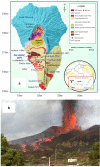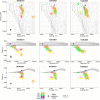Shallow magmatic intrusion evolution below La Palma before and during the 2021 eruption
- PMID: 36509802
- PMCID: PMC9744821
- DOI: 10.1038/s41598-022-23998-w
Shallow magmatic intrusion evolution below La Palma before and during the 2021 eruption
Abstract
La Palma, Canary Islands, underwent volcanic unrest which culminated in its largest historical eruption. We study this unrest along 2021 using Interferometric Synthetic Aperture Radar (InSAR) and a new improved interpretation methodology, comparing achieved results with the crustal structure. We reproduce the final phase of La Palma volcanic unrest, highligthing a shallow magma accumulation which begins about 3.5 months before the eruption in a crustal volume charactherized by low density and fractured rocks. Our modeling, together with our improved pictures of the crustal structure, allows us to explain the location and characteristics of the eruption and to detect failed eruption paths. These can be used to explain post-eruptive phenomena and hazards to the local population, such as detected gases anomalies in La Bombilla and Puerto Naos. Our results have implications for understanding volcanic activity in the Canaries and volcano monitoring elsewhere, helping to support decision-making and providing significant insights into urban and infrastructure planning in volcanic areas.
© 2022. The Author(s).
Conflict of interest statement
The authors declare no competing interests.
Figures









References
-
- Padrón E, et al. Dynamics of diffuse carbon dioxide emissions from Cumbre Vieja volcano, La Palma Canary Islands. Bull. Volcanol. 2015;77:28. doi: 10.1007/s00445-015-0914-2. - DOI
-
- Torres-González PA, et al. Unrest signals after 46 years of quiescence at Cumbre Vieja, La Palma Canary Islands. J. Volcanol. Geotherm. Res. 2020;392:106757. doi: 10.1016/j.jvolgeores.2019.106757. - DOI
-
- Padrón, E., Pérez, N. M., Melián, G. v, Sumino, H. & Alonso, M. Temporal evolution of 3 He/4 He isotopic ratio at Dos Aguas cold mineral spring , La Palma , Canary Islands. In EGU General Assembly 14994 (2021).
-
- Pérez, N. M., Melián, G. v, Hernández, P. A. & Asensio-ramos, M. Diffuse H2 degassing studies: a useful geochemical tool for monitoring Cumbre Vieja volcano, La Palma, Canary Islands. In EGU General Assembly (2021).
Grants and funding
LinkOut - more resources
Full Text Sources

